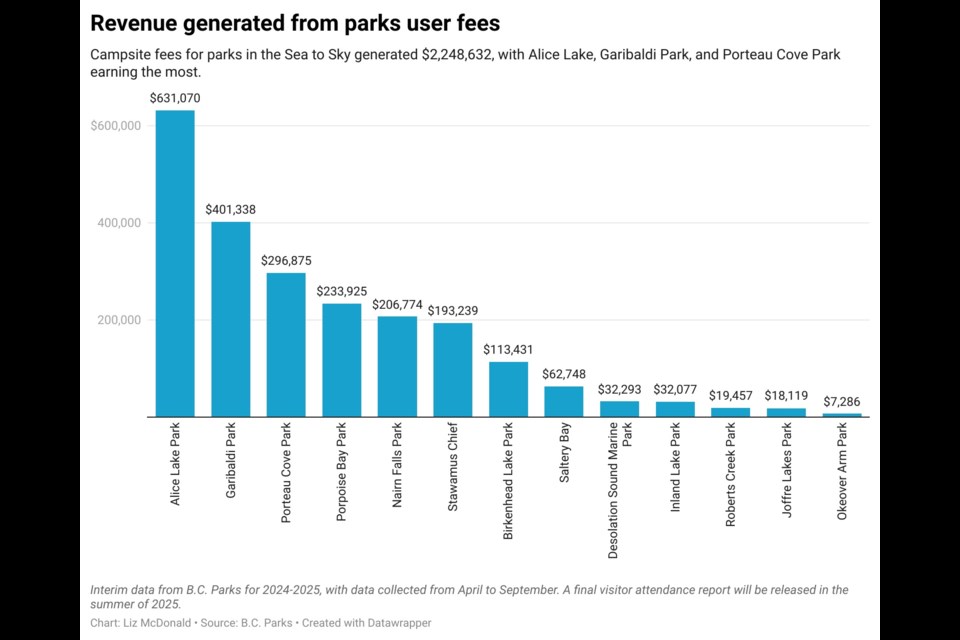BC Parks' interim use data for 2024 was recently released, and if you’re wondering how each of the 22 Sea to Sky B.C. parks stacks up against each other, we’ve charted the data so you can plan your visits accordingly.
The interim report provides visitation data from April to September 2024, and the full report is slated for summer of 2025.
Parks collects visitation data from trail counters, reservations, visitor counts and surveys. The data informs resource allocation, future planning, interest and visitor impact, according to their website.
Happy campers
Anyone who visits Alice Lake for the day or to camp can attest to its popularity. Located 13 kilometres north of Squamish off Highway 99, the lakeside campground and day use site has ample trails, lots of shade and a cool lake with old logs and docks to rest on while swimming. Campers can access shower facilities and pit toilets are onsite. But easy access also means high traffic. Day use last year reached more than 392,000 visitors, behind only Stawamus Chief Park (454,870), Porteau Cove Park (454,759) and Shannon Falls Park (412,542).
On hot summer days, vehicles frequently overflow the Alice Lake parking lot and wind down the dusty, fern-encroached forest service road. With more than 60,000 campers last summer, securing a campsite on short notice is near impossible. BC Parks' web page notes visitors “are strongly advised to make a reservation well in advance of any stay at this park planned for July, August, or September. The park is usually full even on weekdays, with little turnover of campsites in the morning.” Campsite fees from Alice Lake generated $631,070 last year.
Those willing to work a bit harder to experience the natural wonders in the Sea to Sky can appreciate Garibaldi Park if they secure a day-use pass during the summer. Located 64 km north of Vancouver, the 195,000-hectare park has 90 km of hiking trails and is used year-round. With dense forests, alpine meadows and lakes, opportunities for recreation abound, from climbing, biking, swimming and fishing to canoeing, kayaking, snowshoeing and backcountry touring.
Garibaldi has 10 backcountry campsites to choose from that require a reservation, and three shelters. Elfin Lakes hut can sleep 33 people, Kees and Claire Memorial Hut is independently operated by the Spearhead Huts Society, and there is an emergency shelter at Wedgemount Lake. Wilderness camping is an option for mountaineers, climbers, ski-tourers and experienced individuals. There are no garbage facilities, so everything packed in must be packed out.
More than 125,000 people hit up the park for day use last summer, while user fees totalled $401,338 and 43,276 people camped, according to BC Parks—second only to Alice Lake in the Sea to Sky.
Third place for most campsite visitation in the Sea to Sky is Porteau Cove. With oceanfront campsites on the glimmering Howe Sound, the park is popular with scuba divers, windsurfers, marine conservationists, kayakers, canoeists and stargazers. Located 20 km south of Squamish, camping is available year-round.
BC Parks' interim report shows 34,154 campers stayed at Porteau, which raked in $296,875 in park fees. Combining both camping and day-use visitors, the park had the highest overall visitation in the Sea to Sky, at 488,892.
Joffre visitation declining
When comparing the 2024 interim data to reporting from 2023, Instagram-famous Joffre Lakes appears to have seen a 60-per-cent decline in day use visitation. In 2023, the park had 149,993 day visits. In 2024, that number fell to 59,605. Camping declined from 4,592 in 2023 to 3,805 in 2,024, a 17-per-cent decrease. However, since the interim data from 2024 does not encompass the full fiscal year, Parks said it’s too early to say there’s been a definitive decline for 2024.
Reducing visitation stress on Joffre Lakes is a goal of BC Parks and the Lil’wat and N’Quatqua Nations, whose traditional territory includes the park. BC Parks, Lil’wat Nation and N’Quatqua partnered to close the park down for three periods last summer, and a park pass system started in 2021. Indigenous cultural celebrations and practices took place during the closures.
BC Parks and the Ministry of the Environment (MOE) said in an emailed statement the strategy has led to a 25-per-cent reduction in visitors from between 2019 and 2022, “reflecting the objective of the pass to reduce overuse at this park.”
Investment ‘falling behind’
Louise Pedersen, executive director for the Outdoor Recreation Council of BC, said the data confirms what Sea to Sky communities observe.
“The latest BC Parks Visitor Attendance Reports (2018-2024 & 2024-2025 Interim) confirm what recreation groups and local communities have been experiencing first-hand—our parks are busier than ever, and investment in developing and maintaining recreation infrastructure is falling behind,” she said in an emailed statement.
Pedersen highlighted that attendance from BC Parks increased by 4.2 per cent between 2018 and 2024 in the South Coast region, with the Sea to Sky having some of the highest visitation.
“The 2024-25 interim report highlights that Garibaldi, Alice Lake, and Brandywine Falls alone welcomed hundreds of thousands of visitors in just six months,” she said.
But growth doesn’t come without challenges. She pointed to overcrowded trailheads, overflowing parking lots and parks operating at or beyond capacity, negatively impacting visitors.
“To keep up with this growing interest in outdoor recreation, B.C. needs to invest in upgrading and expanding recreation infrastructure, including more parking and improved trail access to reduce bottlenecks at popular destinations, more campsites and facilities to meet increasing demand for overnight stays, and ongoing support for recreation groups and communities that play a key role in maintaining trails and public access,” she said.
BC Parks and the MOE said in an email the budget for this fiscal year is $62.908 million, and did not provide a statement regarding whether the budget is big enough.
“The amount of funding a park receives annually is based on a number of factors, including size, location; consideration of natural, cultural, and recreation amenities of the park; as well as the nature and complexity of facilities, and levels of service required to manage facilities and visitation," they said. "Park funding is dynamic and is impacted by myriad factors including changes in levels of visitation, construction of new facilities, or updates to in park safety requirements."




